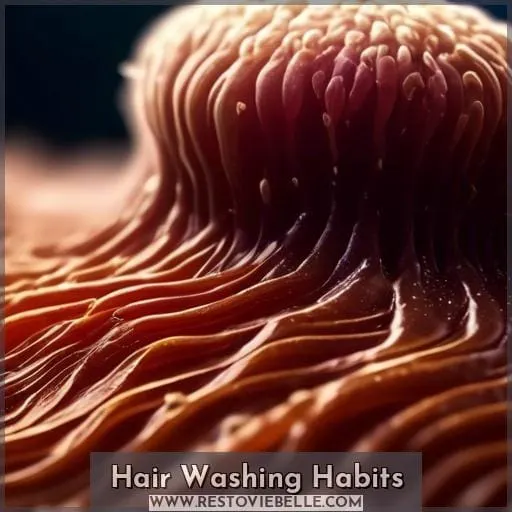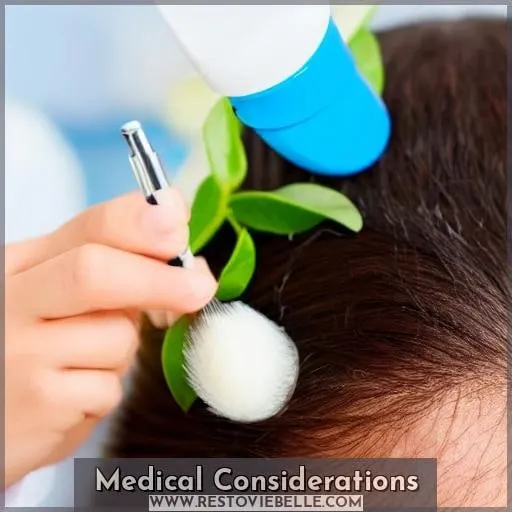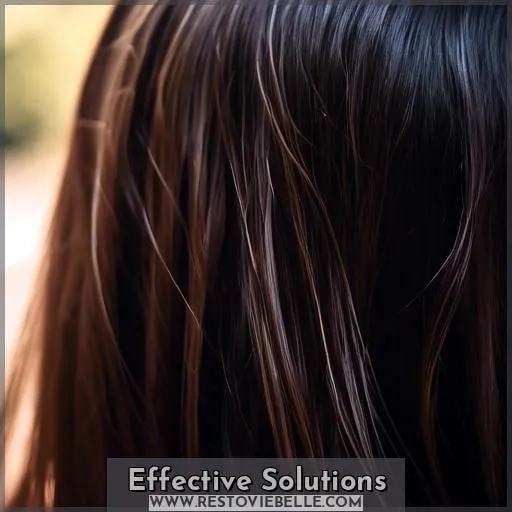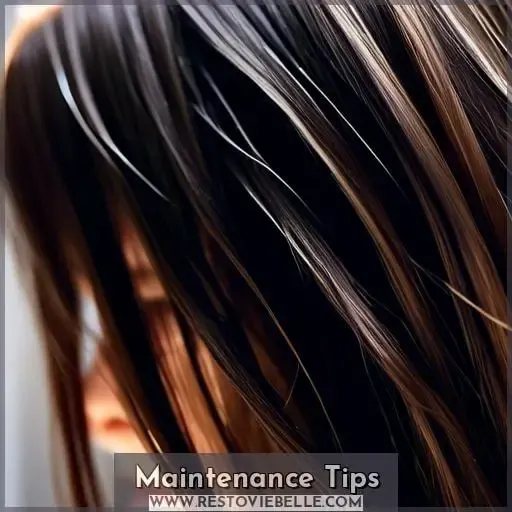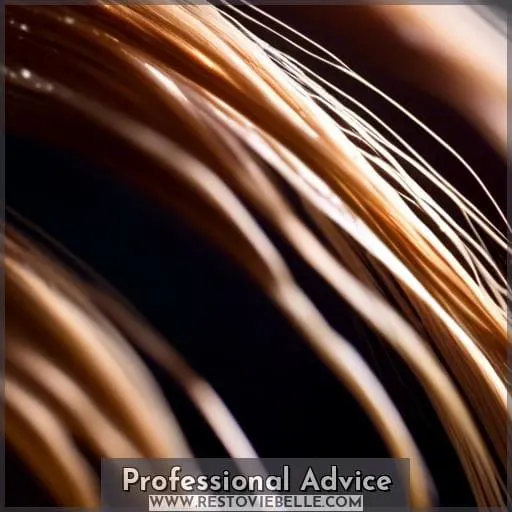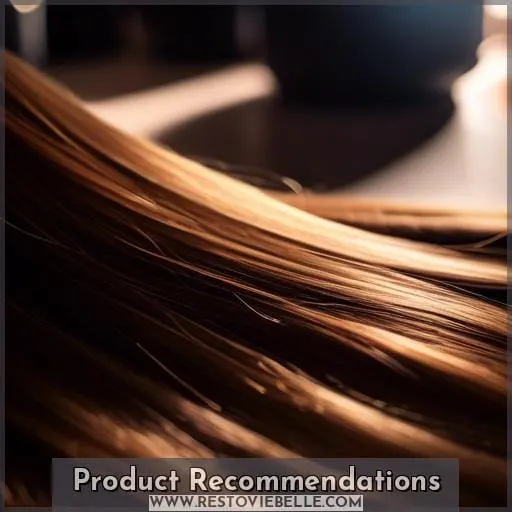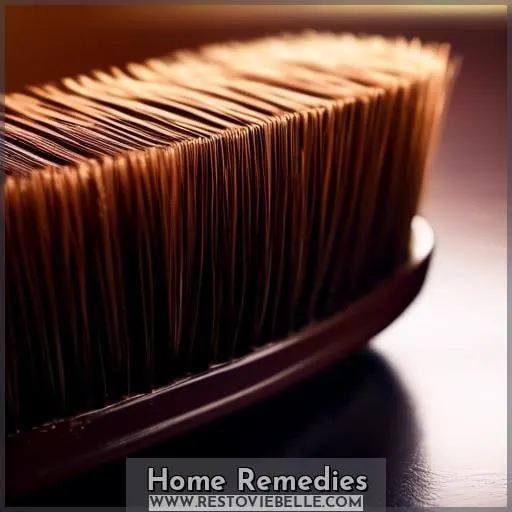This site is supported by our readers. We may earn a commission, at no cost to you, if you purchase through links.
 Struggling with hair that turns into a grease ball quicker than you can say shampoo? You’re not alone. Oily hair can feel like a relentless battle, with every wash seeming to invite the grease back with open arms.
Struggling with hair that turns into a grease ball quicker than you can say shampoo? You’re not alone. Oily hair can feel like a relentless battle, with every wash seeming to invite the grease back with open arms.
But before you throw in the towel, understand that your scalp’s overzealous oil production isn’t a curse—it’s a cry for balance. From the products gracing your bathroom shelf to the pillowcases cradling your dreams, numerous factors could be tipping the scales.
Dive into the world of hair care with us as we unravel the mysteries behind why your hair gets oily so fast and arm you with the tips and fixes to combat the grease.
Your hair gets oily so fast due to overproduction of sebum by the scalp, which can be exacerbated by factors like overwashing, using the wrong hair products, and certain hair types being more prone to oiliness.
Table Of Contents
- Key Takeaways
- Hair Washing Habits
- Styling Practices
- External Influences
- Medical Considerations
- Hormonal fluctuations can significantly impact sebum production in the scalp
- leading to oily hair. Conditions such as puberty
- pregnancy
- and menopause
- or disorders like polycystic ovary syndrome (PCOS)
- can cause hormones to stimulate the sebaceous glands excessively. This results in an increased production of oil
- making the hair appear greasy more quickly.
- Various scalp conditions
- including seborrheic dermatitis (a form of eczema that affects oily areas of the body) and psoriasis
- can contribute to an oily scalp. These conditions often lead to increased sebum production as well as symptoms like itching
- redness
- and flaking. Managing these underlying conditions can help control oiliness.
- Genetics play a crucial role in determining the activity of sebaceous glands. Some individuals may be genetically predisposed to have more active glands
- which produce more sebum. This genetic trait can make their hair get oily faster than others. Understanding one’s genetic predisposition can help in managing expectations and adopting appropriate hair care routines
- Effective Solutions
- Maintenance Tips
- Professional Advice
- Product Recommendations
- Home Remedies
- Lifestyle Adjustments
- Frequently Asked Questions (FAQs)
- Can changing my water type (hard to soft water) affect how quickly my hair becomes oily?
- Does the climate or weather I live in contribute to my hair becoming oily faster?
- Can certain hair treatments or coloring processes make my hair more prone to oiliness?
- How does my scalp’s pH level influence the oiliness of my hair?
- Is there a genetic predisposition to having oilier hair, and can it be managed through lifestyle changes?
- Conclusion
Key Takeaways
- Overwashing hair can lead to increased oil production, while underwashing can cause oil to accumulate, both resulting in hair becoming oily quickly.
- Using the wrong type of shampoo or conditioner for one’s hair type, or applying conditioner to the roots instead of just the mid-lengths to ends, can contribute to greasiness.
- External factors such as stress, diet, and environmental changes can affect oil production in the scalp, leading to oily hair.
- Genetic predispositions and certain medical conditions like seborrheic dermatitis or polycystic ovary syndrome (PCOS) can also cause hair to become oily more rapidly.
Hair Washing Habits
If you’re finding that your hair gets oily quickly, it might be time to reevaluate your hair washing habits. Overwashing can strip your hair of its natural oils, leading to an overproduction of oil as your scalp tries to compensate.
On the flip side, underwashing can leave oil and product buildup on your scalp, making your hair look greasy. Choosing the right shampoo is crucial; for oily hair, consider a clarifying or sulfate-free option to effectively remove oil without over-drying.
Overwashing
Overwashing your hair can lead to a variety of issues, including stripping the scalp of its natural oils, which can cause the scalp to produce even more oil to compensate. This can result in hair that gets oily quickly. Overwashing can also lead to dry, brittle hair, and it can irritate the scalp, potentially exacerbating conditions like dandruff or seborrheic dermatitis.
To avoid the pitfalls of overwashing, it’s important to find a balance that works for your hair type and lifestyle. For some, this may mean washing their hair less frequently. Using the right shampoo for your hair type is also crucial, as some shampoos can be too harsh or not effective enough at removing oil and product buildup.
When you do wash your hair, make sure to use enough water to thoroughly rinse out the shampoo and any dirt or product from your hair and scalp.
Conditioner should generally be applied only to the ends of the hair, where it’s needed most, to avoid weighing down the roots and contributing to oiliness. Additionally, be mindful of the amount of styling products you use, as overuse can lead to buildup that makes hair look greasy.
Regularly cleaning your hairbrush can also help prevent transferring oils and product residue back onto your hair.
If you’re struggling with oily hair, consider using products specifically designed for this issue, such as Neutrogena T/Sal Therapeutic Shampoo or Chi Tea Tree Oil Shampoo, which can help balance scalp oils and reduce greasiness.
Home remedies like aloe vera or cornstarch can also help manage oiliness in between washes.
Remember that factors like diet, stress, genetics, and even the cleanliness of your linens can affect how quickly your hair gets oily. If you’ve tried adjusting your hair care routine and still have issues with oiliness, it may be worth consulting a dermatologist to rule out any underlying medical conditions, such as hormonal imbalances, that could be contributing to the problem.
Underwashing
Underwashing your hair can be just as problematic as overwashing. If you’re not washing your hair often enough, you might be allowing product buildup and natural oils to accumulate, leading to greasy hair.
-
Washing Frequency: It’s essential to find a balance in your hair wash routine. While overwashing can strip your hair of natural oils, underwashing can lead to an oily scalp and hair. Adjust your washing frequency based on your hair type and lifestyle.
-
Shampoo Selection: Using the right shampoo is crucial. For oily hair, consider a clarifying or detox shampoo to help remove excess oil and buildup. Avoid shampoos that are too moisturizing or heavy, as they can contribute to greasiness.
-
Product Buildup: Regularly using styling products without adequately cleansing can lead to buildup, which makes hair look and feel greasy. Incorporate a clarifying shampoo into your routine to help remove residue.
Hormonal fluctuations and genetic influences can also play a role in how quickly your hair becomes oily. If you’re struggling with greasy hair despite a proper hair care routine, it may be worth consulting a dermatologist to explore underlying causes such as hormonal imbalances.
Remember, everyone’s hair is different, and what works for one person may not work for another. It’s about finding the right balance and products that suit your specific hair needs.
Shampoo Selection
Choosing the right shampoo is crucial for managing oily hair. It’s like picking a dance partner – the wrong one can step all over your toes, or in this case, your strands! When selecting a shampoo, consider your hair type and the ingredients.
Sulfate-free shampoos can be gentler, preventing your scalp from going into oil production overdrive. Herbal shampoos might be your scalp’s best friend, offering a natural touch to your hair care routine.
Remember, a good shampoo application technique can make a world of difference – it’s not just what you use, but how you use it. Clarifying shampoos are the secret weapon for cutting through grease, but don’t overdo it, or you’ll be back to square one.
Keep these hair care tips in mind, and you’ll be on your way to saying goodbye to oily hair.
| Shampoo Brand Selection | Hair Care Tips |
|---|---|
| Sulfate-free shampoos can help avoid stripping hair of natural oils, reducing the need for your scalp to produce more. | Apply shampoo with a technique that cleanses the scalp without overstimulating oil glands. |
| Herbal shampoos may offer a gentler, more natural approach to managing oily hair. | Clarifying shampoos are great for a deep cleanse, but should be used sparingly to prevent drying out the scalp. |
| Choose a shampoo that matches your hair type to ensure it addresses your specific needs. | Remember to focus conditioner on the ends of your hair, avoiding the roots to prevent excess oiliness. |
Conditioner Use
When it comes to conditioner use, it’s not just about slathering it on and hoping for the best. Your hair is as unique as you are, and treating it right means paying attention to the details.
- Choose Wisely: Not all conditioners are created equal. Look for products that match your hair type—fine, curly, dry, or oily. Ingredients matter too. Avoid harsh chemicals and embrace natural goodies like essential oils and aloe vera.
- Application is Key: Conditioner should kiss your hair, not smother it. Apply from mid-length to ends, avoiding the roots to prevent greasiness. Think of it as a hydrating hug for the parts of your hair that need it most.
- Frequency Matters: Overdoing it can leave your locks limp, while not enough can lead to a tangle tragedy. Find your sweet spot, which might be daily for dry hair or a couple of times a week for oily strands.
Styling Practices
When it comes to styling practices, it’s crucial to understand how they can contribute to your hair getting oily quickly.
Overusing styling products, choosing the wrong ones, not maintaining clean hairbrushes, and frequently touching your hair can all lead to an increase in oiliness.
It’s important to be mindful of these habits and make adjustments where necessary to keep your hair looking fresh and less greasy.
Product Overuse
Overloading your hair with styling products is like inviting every friend you know to a party in a studio apartment; it’s just too much. When you’re reaching for that bottle of dry shampoo or styling cream, remember, your hair’s not a salad, so let’s ease up on the dressing.
Too much product can leave your hair looking like it’s been through a grease marathon, not the effortlessly chic look you were aiming for.
Choosing the right product is like picking the perfect outfit; what works for a day at the beach isn’t going to cut it for a black-tie event. If your hair could talk, it would beg you to stop smothering it in products that just aren’t its style.
And while we’re on the subject, let’s talk about dry shampoo – it’s like that friend who’s great in small doses but overstays their welcome. Sure, it’s a lifesaver between washes, but rely on it too much, and your hair might just stage a protest.
Incorrect Product Choice
Choosing the wrong hair care products can be like wearing a raincoat in a desert—totally out of sync with what you need. If you’re battling with greasy locks, it might be a sign that your products aren’t playing nice with your hair type.
Think of your shampoo and conditioner as a dynamic duo; if they’re not matched well, they could be throwing a wrench in your hair health, leading to poor results and product buildup.
Incorrect product choice can leave your hair looking as lifeless as a wilted salad. It’s not just about grabbing any bottle off the shelf; it’s about finding the right fit for your hair’s personality. Whether it’s as straight as a ruler or as curly as a corkscrew, your hair has unique needs that can’t be met with a one-size-fits-all solution.
If you’re piling on products and your hair is still throwing a tantrum, it might be time to break up with your current routine and seek hair care advice that aligns with your hair type. Remember, using the wrong product is like trying to fit a square peg in a round hole—it just won’t work.
So, if your hair is quicker to grease than a fast-food fryer, consider this your nudge to reassess your hair arsenal. Swap out those misfit products for ones that will cherish your tresses, and you might just find your hair behaving better than it has in years.
Buildup Issues
Oily hair can be a persistent issue, influenced by a variety of factors. Overwashing your hair can strip it of natural oils, leading the scalp to produce more sebum as a compensatory mechanism. Conversely, underwashing can allow oil and product buildup, contributing to a greasy appearance.
Straight hair texture can also exacerbate oiliness as oil travels down the hair shaft more easily compared to curly hair.
Using conditioner without shampoo can leave residues that increase oiliness. Certain home remedies, like the application of essential oils such as peppermint and tea tree oil, or apple cider vinegar, can help balance scalp oils but may not be suitable for everyone.
For those struggling with oily hair, specific shampoos can help manage sebum production. Products like Neutrogena T/Sal Therapeutic Shampoo, Aveda Scalp Benefits Balancing Shampoo, Chi Tea Tree Oil Shampoo, and Redken Scalp Relief Oil Detox Shampoo are formulated to address oily scalp concerns.
Home remedies can offer natural solutions to oily hair. Aloe vera can help with sebum removal and promote circulation, while cornstarch or baby powder can absorb excess oil. Oil-absorbing sheets offer a quick fix for oil removal, and baby shampoo can dissolve oil without triggering overproduction.
Adjusting your hair washing frequency to suit your hair type can make a significant difference. Avoiding hair straightening, changing pillowcases regularly, and understanding your hair’s susceptibility to oiliness are all practical steps.
Consulting a dermatologist is advisable for persistent issues like excessive sweating or scalp irritation.
For immediate relief from oily hair, dry shampoo, cornstarch or baby powder, oil-absorbing sheets, and gentle cleansing with baby shampoo can be effective.
Chi Tea Tree Oil Shampoo is a product designed to balance scalp oils and strengthen hair. It contains natural antioxidants like tea tree oil and provides a cooling sensation from peppermint oil. However, it’s important to note that some individuals may experience allergic reactions to these ingredients.
Hairbrush Hygiene
Keeping your hairbrush clean isn’t just about hygiene; it’s about maintaining the health and beauty of your hair. A dirty hairbrush can be a breeding ground for bacteria and can reintroduce old product buildup, yeast, and bacteria to your scalp and hair, potentially leading to scalp issues and affecting hair growth.
- Remove trapped hair regularly: After each use, try to pull out any hair that’s gotten tangled in the bristles. This prevents buildup and keeps the brush ready for the next use.
- Deep clean weekly: Mix warm water with a gentle shampoo or apple cider vinegar in a bowl. Submerge the bristles (not the handle if it’s wooden) and let soak for about 20 minutes. Use an old toothbrush to scrub between the bristles.
- Rinse thoroughly: After scrubbing, rinse the brush under running warm water. Make sure to remove all soap or vinegar, as well as any loosened dirt and debris.
- Dry properly: Shake off excess water and lay the brush bristle-side down on a clean towel to air dry. Avoid using a hair dryer as the heat can damage the bristles.
Frequent Touching
Just like keeping your hairbrush clean, avoiding the temptation to constantly touch your hair can work wonders.
| Benefit | Immediate Impact | Long-term Gain |
|---|---|---|
| Hair Growth | ||
| Dandruff Control | ||
| Split End Repair | ||
| Hair Strengthening | ||
| Frizz Reduction |
External Influences
When it comes to managing oily hair, it’s not just about what you do directly to your locks; external factors play a significant role too.
You mightn’t realize it, but the cleanliness of your linens, the amount of stress you’re under, and even your diet can all contribute to how quickly your hair becomes greasy.
If you’re struggling with oily strands despite your best efforts, consider these influences and remember that genetics can also be a factor beyond your control.
Linen Cleanliness
Continuing from the pitfalls of styling practices, let’s talk about the importance of linen cleanliness.
- Linen Change: Swap out pillowcases weekly to prevent oil transfer.
- Washing Frequency: Regular laundering of bed linens keeps them free of oil buildup.
- Pillow Hygiene: Consider materials like silk that may help reduce friction and oil absorption.
- Scalp Irritation: Dirty linens can exacerbate scalp conditions, leading to more oil.
- Oil Production: A clean sleeping environment helps regulate sebum levels.
Stress Impact
Stress can be a real gremlin for your locks, sneakily ramping up oil production on your scalp. When life’s pressures mount, your body responds by releasing hormones like cortisol, which can signal your sebaceous glands to go into overdrive.
This isn’t just a tall tale; conditions like PCOS and seborrheic dermatitis can also join the fray, turning your hair into a slick situation. So, if you’re wrestling with greasy strands, it might be time to tackle that stress—perhaps with a zen moment or two—and keep those hormones in check.
Dietary Effects
Your diet can significantly influence the oiliness of your hair. If you’re grappling with greasy locks, it’s worth considering what’s on your plate.
- B Vitamins: These are your hair’s best friends. Chow down on foods rich in B vitamins to keep your mane looking fresh and clean.
- Low-GI Foods: Steer clear of the sugar rush. Opt for low-GI carbs to prevent a hormonal cascade that can turn your hair into an oil slick.
- Mind the Fats: Not all fats are foes, but it’s a balancing act. Keep the good ones and ditch the bad to avoid adding grease to your tresses.
- Zinc It Up: Zinc is like a bouncer for oil control. Get enough of it to keep sebum production in check.
- Dairy Dilemma: Love cheese? It mightn’t love your hair back. Hormones in dairy can spell disaster for your ‘do.
Genetic Factors
Ever feel like your hair’s got a mind of its own, turning into an oil slick no matter what you do? You might have your genes to thank for that. Genetics can play a big role in how much sebum your sebaceous glands decide to pump out.
These tiny glands are hitched to your hair follicles and when they’re overzealous, it’s like a non-stop oil party on your scalp. But don’t just blame your family tree; hormones are also gate-crashers to this greasy get-together, especially androgens that love to stir up oil production.
If you’re wrestling with an oily scalp, it’s not just about finding the right shampoo; it’s a whole tango with your hormones and genetics. And while you can’t pick your genes, you can definitely choose how to tackle that oil with the right hair care routine.
So, keep your chin up and your hair fresh; it’s all about playing the hand you’re dealt with style.
Medical Considerations
When it comes to managing oily hair, understanding the medical considerations behind why your hair might get greasy so quickly is crucial.
Hormonal fluctuations, such as those experienced during puberty, pregnancy, and menopause, can significantly increase sebum production in the scalp, leading to oilier hair.
Conditions like polycystic ovary syndrome (PCOS) and scalp issues such as seborrheic dermatitis and psoriasis also contribute to excess oil production.
Moreover, genetics can play a role, with some individuals predisposed to having more active sebaceous glands. Recognizing these factors is the first step in adopting a hair care routine that addresses your specific needs.
Hormonal fluctuations can significantly impact sebum production in the scalp
Hormonal imbalances can significantly impact sebum production in the scalp, leading to oily hair. Conditions such as puberty, pregnancy, menopause, or disorders like polycystic ovary syndrome (PCOS) can cause hormones to stimulate the sebaceous glands excessively, resulting in increased oil production and greasier hair.
Additionally, scalp conditions like seborrheic dermatitis and psoriasis can contribute to an oily scalp by increasing sebum production and causing symptoms like itching, redness, and flaking.
Genetics also play a crucial role in determining the activity of sebaceous glands. Some individuals may be genetically predisposed to have more active glands, which produce more sebum, making their hair get oily faster than others.
Understanding one’s genetic predisposition can help in managing expectations and adopting appropriate hair care routines.
Effective solutions to manage oily hair include adjusting wash frequency, using clarifying shampoos, applying conditioner only to the ends, and using dry shampoo. Regular maintenance like cleaning hairbrushes and washing pillowcases weekly can also help manage oiliness.
In cases where routine changes don’t help, consulting a dermatologist is advisable, as they can provide expert opinions and treatments for underlying medical conditions.
leading to oily hair. Conditions such as puberty
Puberty, with its hormonal roller coaster, can turn your scalp into an oil-producing machine, leading to that not-so-fresh feeling in your hair. Hormonal influence is a major player here, as your body’s sebaceous glands get a bit overzealous, cranking out sebum like there’s no tomorrow.
But it’s not just puberty; any condition that messes with your hormones—think pregnancy or PCOS—can have your scalp working overtime.
Scalp conditions like seborrheic dermatitis or psoriasis can also join the greasy party, contributing to an oil buildup that leaves your hair looking like you’ve been working at a fast-food fryer. And let’s not forget genetics; if your family tree is dripping with oily hair, chances are you’ve inherited the trait.
If you’re battling an oily scalp, it’s not just about washing your hair more or less; it’s about understanding the root of the problem. Sometimes, a chat with a dermatologist is what you need to get to the bottom of your greasy woes.
They can offer medical consultations to pinpoint any underlying issues and help you manage that slick situation on your head.
So, if you’re tired of your hair going from fresh to flat faster than you can say dry shampoo, remember it’s not just about what you put on your hair, but also what’s happening inside your body. Hormonal influence, scalp conditions, and genetic factors all play a role in sebum production, and sometimes, professional advice is the key to turning the tide on the oil spill atop your head.
pregnancy
During pregnancy, you might notice your hair getting oilier than usual. This is often due to pregnancy hormones causing a hormonal imbalance, which can lead to an increase in sebum production by the scalp’s sebaceous glands.
Progesterone, which rises during pregnancy, is known for causing premenstrual syndrome and can also make your hair feel greasier.
Moreover, conditions like PCOS can exacerbate these effects due to elevated androgen hormones, which are known to stimulate sebum production. If you’re genetically predisposed to an oily scalp, these hormonal fluctuations during pregnancy might make the situation more noticeable.
While it can be frustrating to deal with greasy hair during such a transformative time, remember that it’s a common and natural response to the hormonal roller coaster your body is on. Managing stress and maintaining a healthy diet can help mitigate some of the oiliness.
If the greasiness becomes too much to handle, consulting with a dermatologist might provide you with tailored solutions to balance your scalp’s health.
and menopause
Menopause can be a real curveball for your locks, often leading to hair loss, a dry, itchy scalp, and even dandruff. As estrogen takes a nosedive, your hair might throw a bit of a tantrum, shedding its lushness and becoming more fragile.
It’s like your hair is on a rollercoaster, except it’s not exactly enjoying the ride.
Imagine your scalp as a garden that’s suddenly hit a dry spell. Without enough estrogen, which is like the water for this garden, things can start to look a bit parched. You might find yourself scratching your head, not just figuratively, but literally, thanks to that itchy scalp.
And if you’re spotting more hair on your brush than usual, you’re not alone. Many women see their hair’s volume and length take a hit during this hormonal shake-up.
But don’t fret! While you can’t exactly tell your hormones to cut it out, there are ways to help your hair through this transition. Think of it as giving your hair a little extra TLC. You might want to cozy up to products that are kind to thinning hair, or turn to home remedies like aloe vera to soothe that itchy scalp.
And hey, changing up your pillowcases more often could be a simple yet effective move.
or disorders like polycystic ovary syndrome (PCOS)
Polycystic ovary syndrome (PCOS) can be a real curveball when it comes to managing your mane.
- PCOS can hike up androgen levels, shrinking hair follicles.
- Smaller follicles may lead to brittle, thinning hair.
- High androgens also mean a scalp that’s more oil-prone.
- This hormonal havoc can leave your hair greasy by day’s end.
It’s a bit of a catch-22: you wash your hair to banish the grease, but that can just rev up oil production. If you’re in this sticky situation, it might be time to rethink your hair care routine and seek professional advice to get to the root of the issue.
can cause hormones to stimulate the sebaceous glands excessively. This results in an increased production of oil
Hormonal fluctuations, such as those experienced during puberty, pregnancy, and menopause, can stimulate the sebaceous glands in your scalp, leading to an overproduction of oil. This excess oil can make your hair appear greasy more quickly than you might expect.
Genetics also play a significant role in this process; if your family members tend to have oily scalps, you’re more likely to experience the same.
Scalp conditions like seborrheic dermatitis can further contribute to an oily scalp by increasing sebum production, along with symptoms like itching, redness, and flaking.
If you’re struggling with oily hair, it’s important to understand that it’s not just about the hair itself. Your hormones are a powerful force affecting the health and appearance of your skin, scalp, and hair.
Adjusting your hair care routine to accommodate these changes can help manage the oiliness. For instance, using a clarifying shampoo, applying conditioner only to the ends of your hair, and incorporating a detox shampoo can be effective solutions.
Regular maintenance like cleaning your hairbrush and washing pillowcases weekly can also prevent oil buildup. Additionally, lifestyle adjustments such as managing stress and eating a balanced diet can influence your scalp’s oil production.
For those with conditions like PCOS, which can cause hormonal imbalances and lead to oily hair, it’s important to seek medical advice and treatment to manage symptoms effectively. Using the right hair care products, such as shampoos formulated for oily hair, can also make a significant difference.
making the hair appear greasy more quickly.
An overproduction of sebum by your sebaceous glands can make your hair greasy quickly.
Factors like hair texture and improper product application can exacerbate this, affecting your scalp health.
Various scalp conditions
Scalp conditions like dandruff and psoriasis can be a real pain, literally and figuratively. If you’re scratching your head wondering why your scalp is acting up, you’re not alone.
- Dandruff: This flaky party crasher is more common than you might think. It’s like uninvited glitter on your shoulders, but less fun.
- Itchy Scalp: An itchy scalp can drive you up the wall. It’s like your head’s throwing a tantrum, and you’re the one who’s to deal with it.
- Hair Loss: Sometimes, your hair decides to pack up and leave. Not ideal when you’re trying to rock your style.
- Scalp Psoriasis: This one’s the tough customer. It’s like dandruff’s meaner cousin, showing up with thick, scaly plaques that just don’t want to leave.
If you’re dealing with any of these, remember that scalp health is key. Keep things clean, but don’t go overboard and strip your scalp of its natural oils. And hey, if things get too gnarly, a dermatologist can be your scalp’s new best friend.
They’ve got the know-how to help you kick those pesky scalp gremlins to the curb.
including seborrheic dermatitis (a form of eczema that affects oily areas of the body) and psoriasis
Seborrheic dermatitis and psoriasis are scalp conditions that can lead to an oily appearance. These issues are often more than skin deep, with potential ties to hormonal fluctuations and genetic predisposition.
| Seborrheic Dermatitis | Psoriasis |
|---|---|
| Often affects oily areas of the body | Typically presents as itchy, scaly patches |
| May be linked to an overreaction to yeast | Believed to be an immune system problem |
| Can be exacerbated by stress and season changes | Can be triggered by injuries, infections, and stress |
| Treatable with medicated shampoos and lifestyle changes | Treatments include medication and lifestyle adjustments |
Imagine your scalp as a bustling city, and these conditions are like unexpected traffic jams—annoying but manageable with the right detours. If you’re navigating these tricky roads, remember that a dermatologist is like a trusty GPS, guiding you to clearer paths.
can contribute to an oily scalp. These conditions often lead to increased sebum production as well as symptoms like itching
Managing oily hair can feel like navigating a minefield, with every step requiring careful consideration to avoid a greasy aftermath. Let’s dive into the crux of the matter, focusing on conditions like seborrheic dermatitis and scalp psoriasis, which can turn your hair care routine into a strategic operation.
Seborrheic dermatitis is like that uninvited guest at your party, causing your scalp to throw a fit with red, scaly, and greasy patches. It’s a condition that loves to hang out in oil-rich areas of your skin, including your scalp, turning your hair into a greasy mess faster than you can say shampoo.
Imagine your scalp deciding to go into oil production overdrive, leaving you with a slick situation that’s hard to manage.
On the flip side, scalp psoriasis is the cousin who shows up with a similar vibe but a different style. It leaves your scalp looking powdery with a silvery sheen, a stark contrast to the yellowish and greasy appearance of seborrheic dermatitis.
It’s like your scalp decided to start its own winter wonderland, minus the joy of snowflakes.
Both conditions can make you feel like you’re fighting a losing battle against oiliness, but there’s a silver lining. With the right approach, including adjusting your hair washing habits, choosing the right products, and maybe even consulting a dermatologist, you can regain control and show your scalp who’s boss.
Remember, it’s not about declaring war on oil but about finding that sweet spot where your hair feels just right.
redness
When it comes to managing oily hair, understanding the root causes and adopting the right hair care practices are crucial. Oily hair can result from a variety of factors, including overwashing, which strips the scalp of its natural oils, prompting it to produce more sebum, and using products not suited for your hair type, leading to buildup.
Straight hair texture can also make oil distribution more noticeable. Essential oils like peppermint and tea tree oil, while beneficial for some, can exacerbate oiliness for others.
For those struggling with oily hair, selecting the right products is essential. Shampoos containing salicylic acid, like Neutrogena T/Sal Therapeutic Shampoo, or natural ingredients such as tea tree oil, found in Chi Tea Tree Oil Shampoo, can help manage oil production.
However, reliance on dry shampoo should be moderate, as it’s a temporary solution that can contribute to buildup.
Home remedies offer a gentler alternative, with aloe vera and cornstarch being effective in removing excess sebum and promoting scalp health. Adjusting lifestyle habits, such as washing frequency and diet, can also make a significant difference.
For persistent issues, consulting a dermatologist is advisable, as underlying conditions like hormonal imbalances or scalp conditions could be the cause.
In summary, managing oily hair involves a combination of choosing the right products, adopting healthy hair care practices, and addressing any underlying health issues. Regularly cleaning hairbrushes, changing pillowcases, and maintaining a balanced diet are simple yet effective steps towards healthier hair and scalp.
and flaking. Managing these underlying conditions can help control oiliness.
Flaking, like snowfall on shoulders, needs managing to curb your scalp’s oil slick.
The answer comes in a little bottle filled with moisture-dense oil. We’re talking about scalp oils, which are formulated specifically to tackle dry scalps and revive dull hair. This under-the-radar scalp and hair treatment is a bonafide miracle worker with some notable benefits, and it’s pretty simple to work one into your regimen.
Keep reading to learn what scalp oils are, how to use them, and which products come recommended by hairstylists.
Genetics play a crucial role in determining the activity of sebaceous glands. Some individuals may be genetically predisposed to have more active glands
Your genetics can significantly influence sebum production, affecting how quickly your hair becomes oily.
If you’ve inherited a genetic predisposition for active sebaceous glands, you might find that your hair gets greasy faster than others.
This is because your scalp conditions, including the rate at which it produces oil, are largely determined by your genetic makeup.
While you can’t change your genetics, understanding this can help tailor your hair care routines to better manage oiliness.
which produce more sebum. This genetic trait can make their hair get oily faster than others. Understanding one’s genetic predisposition can help in managing expectations and adopting appropriate hair care routines
Understanding your genetic predisposition can be crucial in managing oily hair. If your family history includes a trend of excessive scalp oil, it’s likely your sebaceous glands are more active. This doesn’t mean you’re stuck with greasy locks forever, though. Tailoring your hair washing routine to your specific needs can make a big difference.
For instance, if your scalp tends to produce more oil, you might need to wash your hair more frequently with products designed for oily hair, like a clarifying shampoo. Conversely, if you’re prone to dryness, overwashing can exacerbate the issue, so reducing the frequency and using moisturizing products may be beneficial.
In addition to adjusting how often you wash your hair, consider other factors like the type of conditioner you use and where you apply it. Applying conditioner only to the ends rather than the roots can prevent your scalp from becoming too oily.
Also, incorporating a detox shampoo or using home remedies like aloe vera can help manage oil production.
Effective Solutions
If you’re finding that your hair gets oily quickly, it’s important to consider how you’re washing and treating it.
Adjusting the frequency of your washes can help balance your scalp’s oil production, and using a clarifying shampoo can remove buildup that contributes to oiliness.
When applying conditioner, focus on the ends rather than the roots to avoid adding weight and grease.
Additionally, incorporating a dry shampoo into your routine can absorb excess oil between washes, and trying a detox shampoo may further help in managing oil levels.
Adjusting Wash Frequency
When grappling with the slick challenge of oily hair, it’s tempting to wage a full-on war with daily shampoos. But hold your horses! Overwashing can strip your scalp of those precious oils it’s working so hard to produce, leading to an oil production frenzy.
It’s a classic case of too much of a good thing turning bad. Instead, try to find that sweet spot where your hair texture, the whispers of essential oils, and the balancing act of apple cider vinegar come together in harmony.
Clarifying Shampoo Benefits
Clarifying shampoo is your hair’s superhero, swooping in to tackle the villains—buildup from overwashing, excessive conditioner, and reliance on dry shampoo.
Imagine it as a detox spa day for your locks, stripping away the grime without harsh judgment, leaving your hair texture feeling liberated and refreshed.
It’s not about washing away your sins but resetting the balance, ensuring your hair doesn’t bear the weight of past styling choices.
So, before you reach for that dry shampoo again, consider giving your hair a clean slate with clarifying shampoo. It’s like pressing the refresh button, making everything from conditioner application to styling products work better for you.
Conditioner Application Technique
When applying conditioner, focus on the ends, not the roots, to avoid greasiness.
Gently massage the scalp to enhance circulation.
Choose products wisely to prevent buildup and consider your hair texture for optimal results.
Dry Shampoo Usage
After discussing the right conditioner application technique, let’s dive into the world of dry shampoo—a real game-changer for those days when you’re in a rush or want to give your hair a break from frequent washing.
- Dry Shampoo Application: Hold the can about a foot away from your roots and spray sparingly. It’s like adding salt to a dish; you can always add more, but you can’t take it away.
- Dry Shampoo Buildup: To prevent buildup, use it only on oily spots and brush it out after a few minutes. Think of it as a spot cleaner, not a full wash.
- Dry Shampoo Residue: If you’re left with a powdery ghost, massage your scalp to absorb the oil and then brush through. It’s like erasing a chalkboard—some elbow grease is required.
- Dry Shampoo Frequency: Don’t overdo it. Using dry shampoo too often can lead to residue that dulls your hair. It’s a quick fix, not a lifestyle.
Detox Shampoo Integration
Detox shampoos can be a game changer for oily hair.
| Clarifying Shampoo | Benefits | Usage Tips |
|---|---|---|
| Neutrogena Anti-Residue Shampoo | Removes buildup; balances oils | Use weekly or biweekly |
| PURA D’OR Apple Cider Vinegar Shampoo | Clarifies scalp; reduces oil production | Use 2-3 times per week |
| Kenra Clarifying Shampoo | Deep cleanses; refreshes hair | Use every 2-4 weeks |
Work a detox shampoo into your routine to help control oils.
Maintenance Tips
You will want to regularly clean your hairbrush to remove excess oils and buildup.
Also aim to wash pillowcases weekly since dirty linens can transfer oils back to your hair.
Try managing stress levels and eating a nutritious, balanced diet, as these factors may contribute to excess oil production.
Regular Hairbrush Cleaning
You should keep your hairbrush clean to prevent product buildup and oil transfer.
Replace brushes every six months, and disinfect with rubbing alcohol weekly. Proper brush hygiene prevents oil distribution and keeps hair fresh.
Weekly Pillowcase Washing
You’ll want to change your pillowcases at least weekly.
The oils and dirt that build up on fabric can transfer back to your hair, exacerbating greasiness, especially if you have a coarser hair texture.
Frequently washing pillowcases helps minimize this trigger for oily hair.
Stress Management
Stress can indeed play a significant role in the production of oil in your scalp, leading to greasy hair. When you’re stressed, your body releases cortisol, which can activate the sebaceous glands to produce more sebum.
- Practice Relaxation Techniques: Engage in activities like meditation, yoga, or deep breathing exercises to help reduce stress levels.
- Improve Sleep Hygiene: Ensure you get enough quality sleep, as poor sleep can exacerbate stress and hormonal imbalances.
- Establish an Exercise Routine: Regular physical activity can help manage stress and maintain hormonal balance, contributing to healthier hair and scalp.
Balanced Diet Importance
Managing stress and maintaining a balanced diet are key to preventing oily hair. Stress can trigger hormonal imbalances, leading to increased sebum production, while dietary triggers like high sugar and fat can exacerbate oiliness.
If you’re genetically predisposed to an oily scalp, these factors can have an even greater impact. Scalp conditions may also contribute to excess oil, and professional consultation can help address these issues.
To keep your hair care routine on track, consider the following table:
| Do’s | Don’ts |
|---|---|
| Adjust washing frequency | Overwash hair |
| Use clarifying shampoo | Use heavy conditioners |
| Apply conditioner to ends only | Apply conditioner to roots |
| Clean hairbrush regularly | Ignore product buildup |
| Consult a dermatologist if needed | Rely solely on home remedies |
Professional Advice
If you’re grappling with the slick and slippery slope of an oily scalp, it’s time to consider seeking professional advice. A dermatologist consultation can be a game-changer, offering expert opinion and a thorough doctor’s examination to get to the root of the problem.
These medical checkups can reveal if your greasy hair woes are due to hormonal imbalances, dietary habits, or even genetic factors.
Don’t let oily hair weigh you down—sometimes, the best solution is to tap into professional expertise. After all, your hair deserves more than a one-size-fits-all approach, and a dermatologist’s advice could be the secret ingredient to restoring balance to your scalp.
Product Recommendations
Look for shampoos with salicylic acid like Neutrogena T/Sal to remove excess oils and buildup.
Tea tree shampoos like Chi Tea Tree Oil Shampoo can help normalize oil production.
For a deep cleanse, try Redken’s detox shampoo with eucalyptus and citrus oils.
Neutrogena T/Sal Therapeutic Shampoo
When battling the greasy grip of oily hair, Neutrogena T/Sal Therapeutic Shampoo emerges as a knight in shining armor. This powerhouse packs a punch with 3% salicylic acid, diving deep to decimate scalp buildup and dandruff, while soothing your scalp’s itch and flake frenzy.
It’s like a detox spa day for your scalp, minus the fluffy robe. No added colors, preservatives, or fragrances here—just the good stuff, straight up. Imagine giving your hair a fresh start, all while keeping those pesky flakes and oils at bay.
So, if your scalp’s been a bit of a drama queen, T/Sal’s got your back, turning your hair woes into wows with every wash.
Aveda Scalp Benefits Balancing Shampoo
After diving into the world of shampoos that promise to tackle the greasy dilemma, let’s shift our focus to Aveda Scalp Benefits Balancing Shampoo.
Imagine this: a concoction so rich in botanical extracts, it feels like a spa day for your scalp every time you lather up. This gem doesn’t just clean; it harmonizes, bringing your scalp’s natural moisture levels into perfect equilibrium.
Its ingredients are like a soothing balm, offering a calming embrace to your often stressed scalp.
The experience? Utterly invigorating. It’s not just a shampoo; it’s a ticket to a balanced, refreshed head of hair, making every wash an invigorating escape from the mundane.
Chi Tea Tree Oil Shampoo
After exploring the Aveda Scalp Benefits, let’s dive into the Chi Tea Tree Oil Shampoo. This gem, made in the USA, combines tea tree and peppermint oils in a liquid form.
It’s a natural powerhouse for balancing scalp oils, all while giving your hair a refreshing, invigorating boost.
Redken Scalp Relief Oil Detox Shampoo
When it comes to managing oily hair, the Redken Scalp Relief Oil Detox Shampoo could be your knight in shining armor. This shampoo is a game-changer with its unique blend of ingredients designed to tackle that pesky grease.
- Ingredients: It’s packed with micro-sponges and lipacide to absorb excess oil and purify both scalp and hair.
- Brand: Redken is well-known for its salon-quality products, and this shampoo is no exception.
- Price: It’s reasonably priced, considering its specialized formula, with costs varying around $21.88 to $26.00.
- Scent: Expect a refreshing aroma that leaves your hair smelling as clean as it feels.
- Availability: You can find this shampoo at various retailers, both in-store and online, making it easy to get your hands on.
Home Remedies
When dealing with oily hair, it’s understandable to feel frustrated, especially when it seems like nothing you do makes a difference.
However, there are home remedies that can offer a helping hand without the need for harsh chemicals.
Aloe vera, cornstarch or baby powder, oil-absorbing sheets, and opting for baby shampoo are all effective ways to manage oiliness, providing a gentler approach to achieving the balance your hair needs.
Aloe Vera Application
Aloe vera makes an excellent home remedy for oily hair due to its ability to remove excess sebum and promote circulation. Apply pure aloe gel to hair after shampooing and allow it to sit for 15-30 minutes before rinsing out.
The vitamins and enzymes in aloe help control oil production while deeply conditioning hair.
Use aloe 1-2 times per week for best results.
Cornstarch/Baby Powder
Absorb excess oils with cornstarch or baby powder. Simply sprinkle onto roots, leave for 5-10 minutes, then brush out.
Alternatively, use oil-absorbing sheets for quick oil removal or gentle baby shampoo for oil dissolution without over-triggering your scalp’s oil production.
Oil-Absorbing Sheets
Just like a superhero swoops in for a quick save, oil-absorbing sheets are your secret weapon against greasy hair dilemmas.
These nifty little lifesavers offer a fast fix, sliding into your daily routine as effortlessly as a comb through well-conditioned locks.
Baby Shampoo Option
The baby shampoo option can help with oily hair as its formula is extra gentle. Baby shampoos have:
- Sulfate-free formulas
- Added moisturizers
- Gentle cleansing agents
- Low likelihood of scalp irritation
This allows them to cleanse hair without triggering excess oil production like regular shampoos might.
Lifestyle Adjustments
When it comes to oily hair, making a few lifestyle changes can really help control excess oil production.
Try washing your hair less often, avoiding heat styling tools that can stimulate oil glands, and changing your pillowcases regularly to prevent oil and dirt buildup.
Small adjustments like these may make a big difference in keeping hair grease-free.
Washing Frequency Modification
You’ll want to modify how often ya wash to help with oily hair. Start by assessin’ current frequency – are ya overwashing and strip- ping too many oils? Or underwashing and lettin’ buildup occur? Adjust accordingly – see what works best for your hair type.
| Frequency | Effect |
|---|---|
| Daily washing | Can dry out hair |
| Every 2-3 days | Helps reduce oil |
| Weekly washing | Allows more oil buildup |
Monitor as ya find the right balance for you.
Avoiding Hair Straightening
You may wish to avoid frequently straightening your hair, as this can strip natural oils and cause overproduction, irritation, and imbalance.
Seeking hairstyles complementing your texture preserves scalp health. When opting for straight looks, gently stretch hair while blowdrying instead of harsh chemical processing.
Select bonding treatments conditioning each strand. This retains integrity despite environmental factors or heat styling.
Gentle straightening allows moderating oil production.
Regular Pillowcase Change
Change your pillowcases at least once a week. Cotton provides better breathability; silk causes more oil transfer. Dirty linens rub residue into hair, worsening oiliness. Replace old, stained cases regularly too.
Choosing suitable fabrics and washing bedding frequently prevents product buildup and excess grease.
| Frequency | Material | Cleanliness | Replacement | Choice |
|---|---|---|---|---|
| Weekly | Cotton | Fresh | When Stained | Breathable |
| Silk | Clean | Every 6 Months | Absorbent |
Frequently Asked Questions (FAQs)
Can changing my water type (hard to soft water) affect how quickly my hair becomes oily?
Yes, switching from hard to soft water can indeed affect how quickly your hair becomes oily.
Soft water can make your hair greasy and flat because it causes your hair to hold onto products, leading to buildup.
Does the climate or weather I live in contribute to my hair becoming oily faster?
Yes, the climate or weather you live in can significantly contribute to your hair becoming oily faster.
High temperatures and humidity can increase your scalp’s oil production, leading to greasy hair.
In contrast, cold weather can also make your hair appear oilier due to increased indoor heating and wearing hats, which trap heat and sweat close to the scalp.
Can certain hair treatments or coloring processes make my hair more prone to oiliness?
Yes, certain hair treatments and coloring processes can indeed make your hair more prone to oiliness.
Imagine diving into a pool of vibrant colors, only to emerge with strands that feel like they’ve been on a greasy food binge. That’s because treatments like bleaching or coloring can strip your hair of its natural oils, prompting your scalp to go into overdrive and produce even more oil to compensate.
It’s like your scalp is throwing an oil party, and everyone’s invited! So, if you find your hair getting oily faster post-coloring, it’s not just your imagination playing tricks on you. Your scalp’s just trying to balance things out, albeit a bit too enthusiastically.
How does my scalp’s pH level influence the oiliness of my hair?
Your scalp’s pH level plays a crucial role in the oiliness of your hair. A balanced scalp pH helps maintain healthy sebum production.
If the pH leans too alkaline, it can strip away natural oils, prompting your scalp to overcompensate by producing more oil. Conversely, an overly acidic environment can irritate the scalp and disrupt its natural balance.
Aim for products that support a scalp pH close to its natural range, around 5 to
Is there a genetic predisposition to having oilier hair, and can it be managed through lifestyle changes?
Yes, there’s a genetic component to having oilier hair, akin to inheriting a family recipe that makes your hair a bit too flavorful.
But don’t fret; like tweaking a recipe, lifestyle changes can dial down the grease. Adjusting your washing routine, choosing the right products, and embracing a healthy diet can help manage your hair’s natural zest.
Conclusion
Navigating the oily waters of hair care can be a daunting voyage, but with the right compass, you’ll find your way to balanced shores.
With these tips and fixes, you’ll steer clear of the grease and towards hair harmony.

